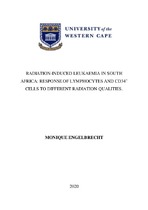| dc.contributor.advisor | de Kock, M. | |
| dc.contributor.advisor | Vandevoorde, C. | |
| dc.contributor.author | Engelbrecht, Monique | |
| dc.date.accessioned | 2021-03-23T09:04:52Z | |
| dc.date.available | 2021-03-23T09:04:52Z | |
| dc.date.issued | 2020 | |
| dc.identifier.uri | http://hdl.handle.net/11394/8012 | |
| dc.description | Philosophiae Doctor - PhD | en_US |
| dc.description.abstract | Epidemiological studies have highlighted that leukaemia can be considered as the most prominent malignancy after radiation exposure during childhood. The lifetime risk on radiation-induced leukaemia for a given dose is 3 – 5 times higher for children compared to adults. The high risk at a young age is related to the elevated sensitivity of the red bone marrow where haematopoietic stem and progenitor cells (HSPCs) are located. HSPCs self-renewal capacity and long-life span increase their susceptibility to DNA damage accumulation, making them a major target of radiation-induced carcinogenesis. Proton beam therapy (PBT) is increasingly used to treat paediatric brain tumours due to its dose sparing properties compared to conventional X-ray based radiotherapy. | en_US |
| dc.language.iso | en | en_US |
| dc.publisher | University of the Western Cape | en_US |
| dc.subject | Radiation | en_US |
| dc.subject | South Africa | en_US |
| dc.subject | Leukaemia | en_US |
| dc.subject | CD34+ cells | en_US |
| dc.subject | Radiotherapy | en_US |
| dc.title | Radiation-induced Leukaemia in South Africa: Response of lymphocytes and cd34+ cells to different radiation qualities | en_US |
| dc.rights.holder | University of the Western Cape | en_US |

